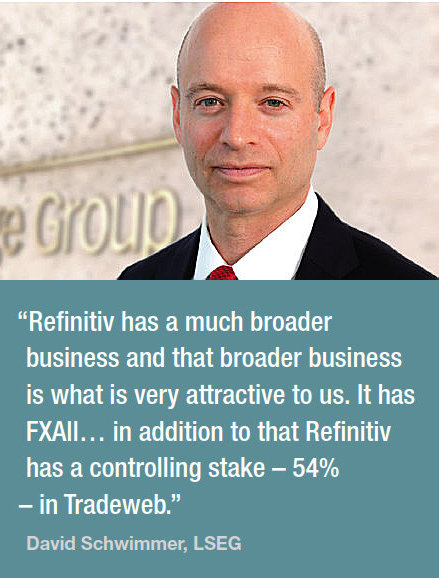Consolidation of the market continues, yet there are clear areas of growth in 2020.
In the corporate and government bond trading space for dealer-to-client trading, the ongoing success of Bloomberg, MarketAxess and Tradeweb has provided little room for new entrants, with many rival and new entrants rising, merging and occasionally falling by the wayside since The DESK launched in 2014.
Our prediction for 2020 is that consolidation will continue in the credit space, while the three big battlefields in secondary trading are likely to be around data, auto-execution and dealer-to-client US Treasuries.
Everybody loves trading data…
…But nobody wants to pay for it. Many providers have tried to support better data provision however creating a sound commercial model around its delivery is more difficult, often due to the challenge in pricing the value derived from it.
The recent closure of pre-trade data provider B2Scan did not surprise many in the market, where it had struggled to reach a successful commercial model. Its peers in the pre-trade space have been cutting their losses in recent years. Algomi made a £4 million loss in 2018 according to its accounts, down from £10.5 million the year before. Neptune Networks, which standardises the distribution of dealer axes made a £745k loss last year, down from £921k in 2017.
Some data tools have thrived, often as part of a larger business. MarketAxess has seen success with its Composite+ pricing tools to support activity such as internal crossing and has partnered with Virtu Financial, using it to offer real-time price evaluation for fixed income ETFs. Since going public at the start of the year, Tradeweb has reported growth in its data business of 13% in Q2 and 8% in Q3.
The London Stock Exchange Group (LSEG), owner of the MTS bond trading platform, reported that 75% of its total business came from data in 2018 – worth £3.2 billion – and in 2019 acquired Refinitiv to expand its capabilities.
 David Schwimmer, CEO at LSEG, played down the importance of Refinitiv’s trader terminal business when asked about the acquisition at the Sibos conference in September 2019, “There’s a misperception out there that Refinitiv is based on the Eikon terminal. Refinitiv has a much broader business and that broader business is what is very attractive to us. It has FXAll… in addition to that Refinitiv has a controlling stake – 54% – in Tradeweb.”
David Schwimmer, CEO at LSEG, played down the importance of Refinitiv’s trader terminal business when asked about the acquisition at the Sibos conference in September 2019, “There’s a misperception out there that Refinitiv is based on the Eikon terminal. Refinitiv has a much broader business and that broader business is what is very attractive to us. It has FXAll… in addition to that Refinitiv has a controlling stake – 54% – in Tradeweb.”
He emphasised that while headcount was reducing, data consumption was growing amongst trading firms, largely being consumed by machines.
The Intercontinental Exchange (ICE) has pursued a data-led strategy over trading, based on the benchmark indices that the firm has acquired in the fixed income space, with CEO Jeff Sprecher admitting to analysts in Q3 2019, “We were late, if you will, to building out an execution venue … And so we pivoted hard to build out all of the other things that we know tend to flow from having a good execution venue, and so we built out the data platform and are the predominant fixed income data provider now.”
While intermediated data has continued to prove useful for traders, the inclusion of indicative pricing data is too often misused – report traders – making direct streaming of pricing data from counterparties more attractive, allowing the dealers to avoid information leakage and the buy-side to be certain that prices are firm.
Auto-execution boom
That streaming of prices is enabling platforms to deliver automated execution tools; by the end of Q3 2019 Tradeweb was seeing an average daily volume of US$3 billion on its AiEX automated trading tool, up from US$600 million in 2015 (see Fig. 1).
 “With automation now we’ve basically given clients a rules-based algorithm where they’re programming across the characteristics that they care about to completely automate this process, based on a number of different criteria,” said Lee Olesky, CEO of Tradeweb, speaking with analysts in Q3. “I expect that will continue to grow in terms of the take-up, but also the sophistication that goes into these automated tools.”
“With automation now we’ve basically given clients a rules-based algorithm where they’re programming across the characteristics that they care about to completely automate this process, based on a number of different criteria,” said Lee Olesky, CEO of Tradeweb, speaking with analysts in Q3. “I expect that will continue to grow in terms of the take-up, but also the sophistication that goes into these automated tools.”
MarketAxess has also reported increased adoption of its Auto-Ex functionality with 63 firms reportedly now actively using it in Q3 2019 up from 28 in Q3 2018. The firm saw over 115,000 Auto-Ex trades in Q3 which it reported was a 96% increase year-on-year, with over US$22 billion in quarterly volume marking a 156% increase year-on-year (see Fig. 2).
 “We’re continuing to invest in our automated trading functionalities by developing a new liquidity provisioning solution,” said Chris Concannon, president and COO, MarketAxess. “Our new autoresponder tool will allow investors to automatically respond to request for liquidity via anonymous, Open Trading marketplace based on a set of predefined rules and criteria. Portfolio managers and their traders will be able to automatically monitor and react to unique pricing opportunities across their portfolios.”
“We’re continuing to invest in our automated trading functionalities by developing a new liquidity provisioning solution,” said Chris Concannon, president and COO, MarketAxess. “Our new autoresponder tool will allow investors to automatically respond to request for liquidity via anonymous, Open Trading marketplace based on a set of predefined rules and criteria. Portfolio managers and their traders will be able to automatically monitor and react to unique pricing opportunities across their portfolios.”
US Treasury market now intensely competitive
Some 53% of asset managers have seen a fall in the cost of Treasury trading over the past year according to the October 2019 report ‘Buy-Side Treasury Trading 2019: The Mechanism and the Market’ by Tabb Group. Tradeweb and Bloomberg have been the dominant forces in dealer-to-client trading, but a tipping point has been reached with interdealer businesses seeking to break into the D2C space.
In late 2014 US treasury interdealer markets were a two-horse race between ICAP’s Brokertec and Nasdaq’s eSpeed, dealer-to-client platform trading dominated by Tradeweb and Bloomberg. That has changed dramatically, even within the last year.
In the third quarter of 2019, US treasury interdealer trading platforms were on a tear. In Q3, Shaun Lynn, president at BGC reported that its Fenics UST platform had seen its market share in on-the-run US Treasury trading on a central limit order book (CLOB) increase from 2% in September 2018 to 8% in September of 2019, citing Greenwich Associates data. Against the previous quarter its volumes were up 50% against a 2% rise for Federal Reserve Primary Dealer Treasury Volumes, pushing revenues up by 12% over the previous quarter.
“Fenics is the growth engine of the company,” he said.
Nasdaq Fixed Income, formerly eSpeed, the US Treasuries interdealer market, saw overall quarterly volume rise from US$2.7 trillion of notional traded in Q1 to US$3 trillion in Q3, however its revenue fell from US$10 million to US$8 million over the same period.
In Q2, CEO Adena Friedman told investment analysts, “In the US Treasuries business, it’s been a highly competitive highly electronic trading environment for a long time. And so I think that for us it’s really a matter of how do we make sure that we are evolving our platform to meet the evolving needs of the broker-dealer community.”
The market leader in US Treasuries trading, Brokertec, saw its ADV in Q3 increase 34% over the CME’s the previous quarter to reach US$179 billion, generating US$51 million of revenue.
MarketAxess also reported in Q3 that LiquidityEdge, the Treasuries trading platform it has acquired, had reached an average daily volume (ADV) of US$18 billion that quarter, breaking past the US$15 billion ADV for the first time, and – prior to Q4 2018 – having never previously hit US$10 billion.
MarketAxess’ Concannon told analysts in Q3, “While LiquidityEdge primarily serves the interdealer treasury market today, our dealers see a strategic opportunity to grow the business by building custom dealer to client connections, which we hope to launch in the first half of 2020.”
A timeline of consolidation in bond markets
2013
• MarketAxess acquires market data and post-trade service firm, Trax
• MarketAxess and BlackRock’s Aladdin announce Open Trading partnership in US credit
• Morgan Stanley Bond Pool closed
• Goldman Sachs’ GSessions closed
• Citi Credit Cross closed
• Nasdaq acquires US Treasury trading platform eSpeed from BGC
2014
• MTS acquires Bonds.com
2015
• Bondcube shuts down in 2015 shortly after launching
• BGC acquired GFI including GFI Creditmatch platform
• MarketAxess and BlackRock expand open trading partnership to Europe
2016
• State Street FI Cross shut in 2016 leading to closure of Bloomberg’s associated BBX crossing product
• Bloomberg acquires the Barclays fixed income indices business
2017
• Electronifie was bought by Trumid, two years after both launched
• LSEG bought the Citi YieldBook bond analytics and index business for US$685 million in May
• Pre-trade data service Algomi buys the Alfa platform from AllianceBernstein in May
• ICE buys the Bank of America Merrill Lynch fixed income index platform
• Euronext’s BondMatch was shut down on 21 July 2017 with Euronext Synapse, the new multilateral trading facility (MTF) powered by Algomi being mooted as its replacement
• KCG (now Virtu Financial) sold its Bondpoint platform to ICE in October
• ITG shut POSIT FI officially in November
2018
• CME bought NEX Group in March 2018, in a deal worth US$5.5 billion, bringing the major Treasury cash and futures platforms under one roof
• BGC acquires embonds
• ICE bought TMC Bonds, a retail corporate bond trading system, for $686 million in May
• Also in May 2018 IHS Markit buys Ipreo, the bond issuance data and workflow firm, for US$1.86 billion
2019
• LSEG announces acquisition of Refinitiv, including a 50% share in Tradeweb
• In August, emerging markets specialist LiquidityFinance announces a partnership with Seagate Global with a merger expected in 2020
• ICE buys Bank of America Merrill Lynch fixed income volatility indices
• B2Scan shuts in October
• MarketAxess completes acquisition of US Treasury platform LiquidityEdge in November
©The DESK 2019
©Markets Media Europe 2025












